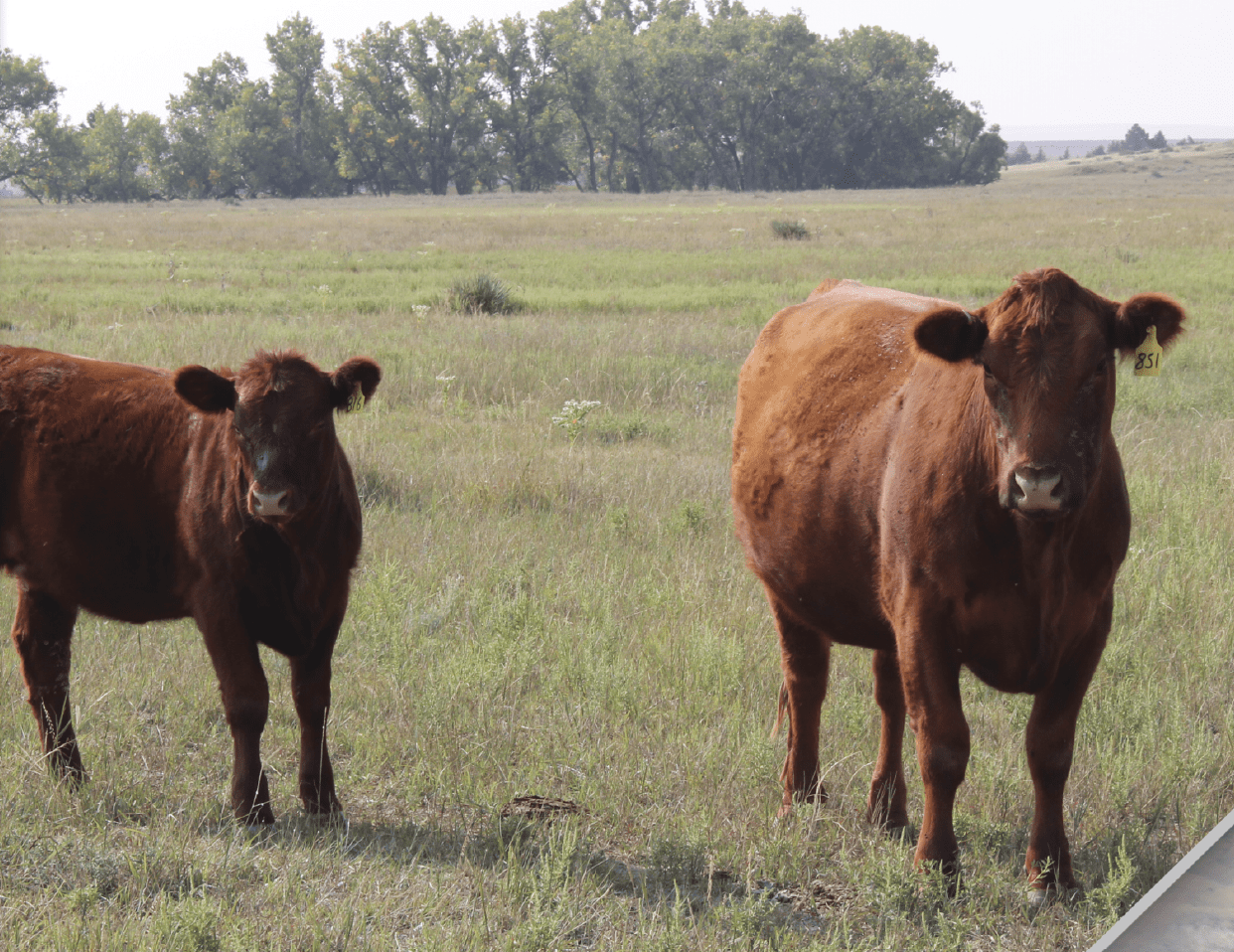

External parasites during the summer months can be a heavy burden on cattle and producers alike.
Decreased performance, painful bites, and risk of disease transmission are common among many of these nuisance pests.
Controlling these parasites takes properly timed management.

It is estimated that horn flies alone may account for up to a billion dollars of damage and loss to the cattle industry each year.
Economic impact can be seen on individual animals with as little as 200-300 flies per animal.
This can be visualized by horn flies covering the withers and going about halfway down the side.
The economic impact hits producers in decreased average daily gain and reduced weaning weight of calves.
Each horn fly will take 20-30 blood meals each day.
They spend the vast majority of their lives on the backs of cattle and only leave the animal to lay eggs on fresh manure patties.
Populations typically rise in late May and persist during the summer months.
Stable flies are also blood feeders and feed on the lower limbss.
They deliver a very painful bite during feeding.
Infested animals are often seen switching their flanks, moving constantly, flicking tails, and even standing in water in attempts to escape the painful bites.
It has been estimated that as little as five flies per leg can impact performance in beef cattle.
Stable flies spend very little time on cattle themselves and only feed during daytime hours.
Different from other flies, stable flies lay their eggs in decaying organic matter (e.g., spilled feed, undisturbed manure, decomposing hay bales).
Face flies feed on the protein-rich secretions from the eye and nose.
Face flies are the primary vector for spreading the bacteria that cause the disease known as pinkeye.
Pinkeye in cattle is also a major economic concern to producers.
It has been estimated that pinkeye accounts for 150 million dollars in losses per year through treatment costs and decreased production.
Although multiple factors play a role in pinkeye, face flies are generally a part of the spread of the disease.
As with horn flies, face flies lay eggs on fresh manure patties.
One main difference between the behavior of these two pests is face flies can travel several miles between animals and spend less time on the animals themselves.
It is important to understand that combating these external parasites during the summer months takes a multimodal approach.
There is a vast array of products on the market to help control these pests.
Each product is designed to work in a specific way, against certain targets, for a specified amount of time.
Expecting a product to last from turn out to grass until the first frost, or to eliminate 100% of the pests, is unrealistic and close to impossible.
Producers should develop an integrated management plan to combat these pests.
Stable flies tend to be more of a confinement or barnyard issue but have increased occurrence in pasture settings.
Typically, this is due to winter feeding sites and build-up of hay residue and manure.
This mixture provides an ideal location for stable flies to flourish.
Rolling out hay during the winter feeding months greatly reduces the number of stable fly larvae that survive the winter.
Round bale feeders tend to leave a large amount of residue on the ground post winter feeding and can yield up to 1 million more stable flies the next grazing season.
Cleaning feeding areas prior to late spring will reduce the habitat for stable fly larvae to develop.
Cleaning can include scraping, composting, or even dragging the sites with a harrow.

There are a multitude of animal health products to help specifically control targeted external parasites in grazing cattle.
They can include insecticide impregnated ear tags, pour-ons, sprays, oilers or dusters, injectable products, and feed-through products.
Usually, a combination of these products is utilized to provide coverage during the summer months.
As with any animal health product, it is extremely important to read and follow all label directions of use.
It is also important to note that most of these products have a slaughter withdrawal time, so documentation of treatment dates is crucial.
Common classes of insecticides include pyrethroids, organophosphates, and macrocyclic lactones.
Continued use of one class of product will promote resistance in the area fly population.
So, using one chemical class each season and rotating classes on a seasonal basis is critical to maintain the usefulness of these products.
Timing is a critical component of insecticide use. Each of these products has an expected duration of efficacy.
Producers often utilize these products like ear tags early in the spring prior to turnout, but the products start to lose potency and efficacy in the late summer months when we need them most.
Holding off treatment until fly levels on cattle hit the critical point (100-200 flies per animal) can help extend duration into the summer.
If additional treatment is indicated later in the season after multiple applications of a product or an ear tag has already been used, alternate the insecticide class when changing control methods late season.
Work with your local veterinarian who understands your individual management strategies to tailor fit a plan.
Fly tags are excellent tools. To get the most benefit from them, wait until the middle of May or even June to put them in to ensure the tags still have effect later into the season when they are most needed.
Many available tags may have effective duration of 12-20 weeks.
It is recommended to only tag cattle once per season. It is also important to remove these tags at the end of the season.
Leaving the tags in will expose these parasites to a sub-therapeutic level of the active chemical that greatly increases the likelihood of resistance development.
Recently, the EPA (Environmental Protection Agency) issued a ban of the insecticide chlorpyrifos use in food or feed crops.
There has been an ear tag that uses this chemical on the market.
As of March 1, 2022, animals administered these tags cannot be sent to slaughter within one year after tag removal.
These ready-to-use formulations are administered to the topline of cattle and dosed by bodyweight.
Pour-on products work by direct contact on pests, so complete coverage from the poll to tailhead is important.
Common products have label claims against flies, lice, and even ticks.
Reapplication of these products may be necessary as expected duration of efficacy is 2-4 weeks.
Use the economic threshold of approximately 200 flies per animal as an indication for retreatment.

Many producers utilize self-applicators such as dusters or rubs in the pasture setting.
To increase the effectiveness, fencing off and controlling entry points of commonly used areas can ensure application to the animals of the herd.
These areas can be watering or mineral source areas.
Read the label instructions carefully as these products may require specific carriers to work properly.
Recharging these sites with the proper product mixture in the recommended intervals will also have to be done during the season.
Some products available come as a concentrate to be mixed with water before applying to cattle.
These prod ucts can be useful for individual animals or groups of animals.
Options for administration can range from automatic spray devices in facilities to handheld 4-wheeler sprayers for use in the field.
With optimal coverage of the animals, 2-4 weeks of efficacy can be achieved.
These products are fed to cattle and are commonly included in certain mineral products.
The products pass through the animal and have efficacy in the manure.
They work by either destroying developing larvae or disrupting the normal development process of horn, face, and house flies.
This process reduces the amount of new fly activity in a given area.
However, flies do have the ability to travel over distances from neighboring operations.
Timing of feeding these products is critical and should be targeted to begin before the vector season starts and end after a killing frost.
Endectocides are the class of products whose main use is control of internal parasites (dewormers).
The most common class are the macrocyclic lactones. Common ingredients in this class include the ivermectins.
These products come in injectable and pour-on formulations.
Even though their main action is against internal parasitism, their residual activity does provide coverage against external parasites for a period of time.
Reliance and reapplication of these products during the grazing season is not recommended for fly control due to resistance issues with internal parasites.
These products are often administered at the beginning of the grazing season and the activity against external parasites can be seen early in the season.
External parasites are annoying to livestock and costly to animal performance. Timely management and appropriate use of insecticides will help minimize their impact.

A.J. Tarpoff was born and raised in Edwardsville, Illinois. A.J.’s family owned and operated a beef processing plant and a steakhouse. He received his B.S. in Animal Science at Kansas State University in 2010. In 2012, he received his D.V.M. and M.S. in Biomedical Science at Kansas State University. He spent four years in feedlot production practice before returning to his alma mater to serve as the Beef Extension Veterinarian in Kansas. A.J. has a 70% extension, 20% research, and 10% teaching appointment. He works closely with producers, practicing veterinarians, and members of industry to bring relevant extension and education that improves cattle health and the productivity of the beef industry.
Get all Doc Talk episodes straight to your email inbox!